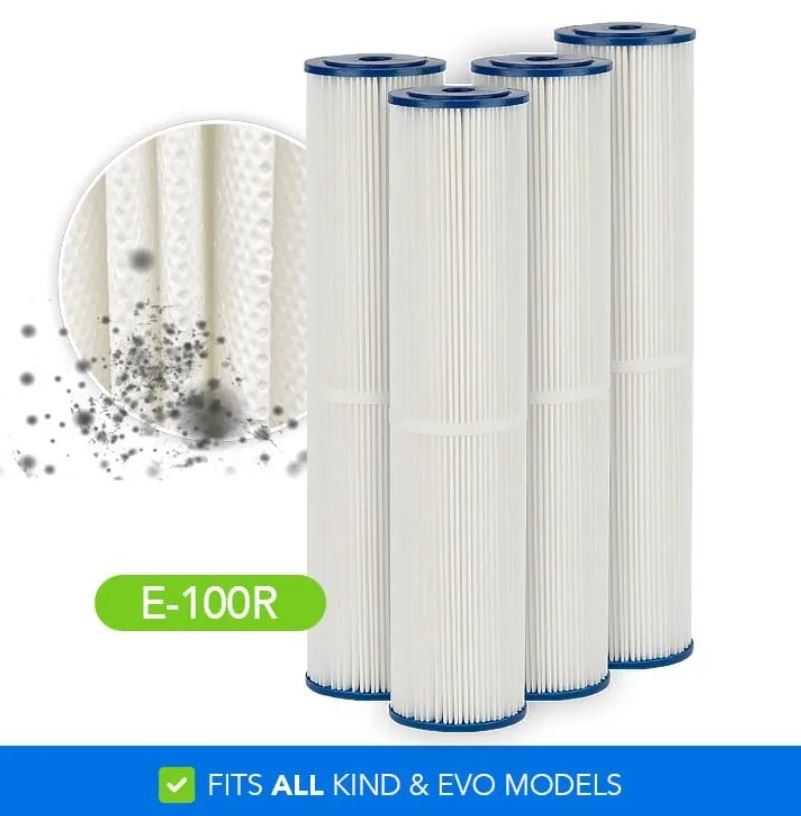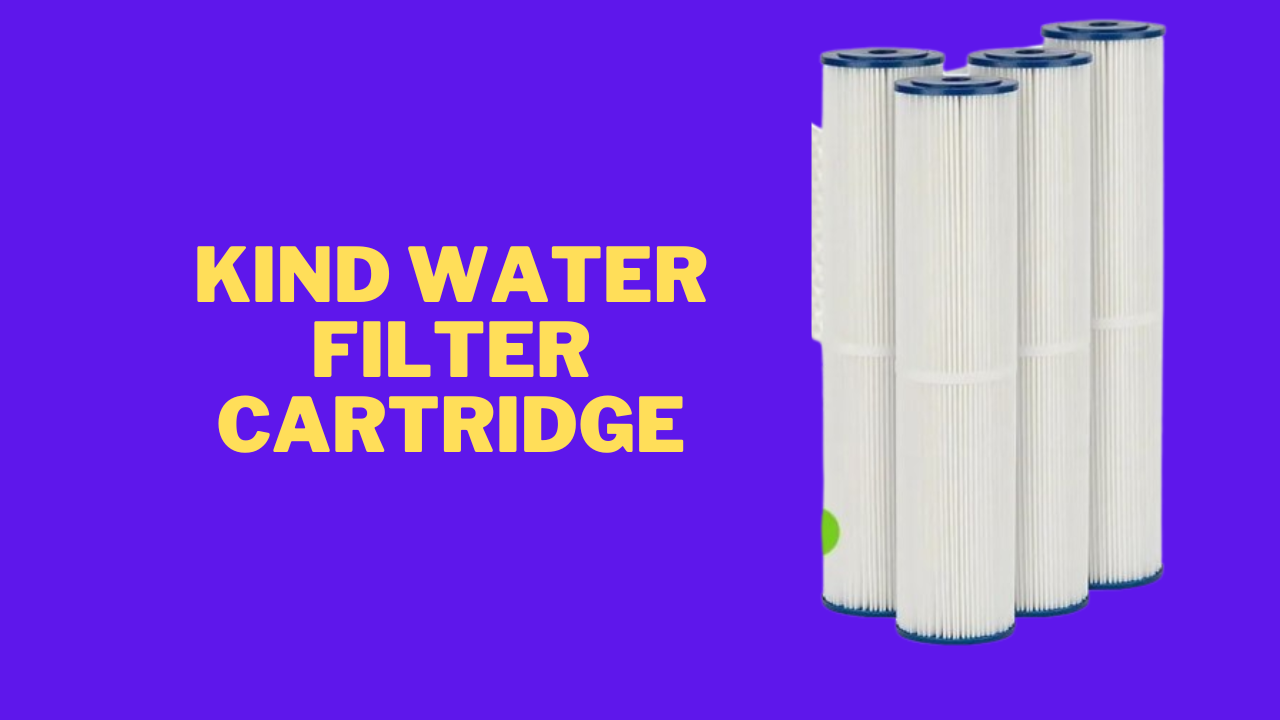Trapping and removing debris, rust specks, suspended solids, and other water-contaminating particles is the job of a sediment filter cartridge. One of the best filter cartridges is the Kind water filter cartridge that catches silt, which may discolor water and cause pipes to age. Clogged fixtures and valves, as well as broken water heaters, are some of the appliance problems that can result from sediment accumulation. It also hinders the efficiency of filtering technologies such as reverse osmosis and ultraviolet purification.
Understandably, the most important part of water filtration is the sediment filter, which keeps the water clean. In this post, we shall have an in-depth discussion about the water filter cartridge from the Kind.

Kind Water Filter Cartridge
| Micron-rating | 5-micron |
| Replacement | Every 12 months |
| Flow rate | 15 GPM |
| Installation | Easy |
| Compatibility | All Kind whole-house sediment filters and softeners(E-1000, E-2000, E-3000) |
| Price | Affordable |
The E-100R pleated sediment water filter cartridges by Kind are great for commercial and household water filtration and softener systems because they decrease the particles of sand, grime, silt, rust, and scale.
Composition
These filter cartridges have a polypropylene core and media composed of polyester and resin-impregnated cellulose.
Contaminants removal
These compounds prevent bacteria, adsorb undesirable chemicals, and trap suspended particles; they also neutralize acids and other chemicals that alter the water’s chemical composition.
Efficiency
The pleated shape increases the surface area of the filter, which can increase its lifespan and remove chemicals and unwanted particles from water through biological processes, adsorption, and a semipermeable barrier.
Micron rating
Following the tiniest hole size of 1 micron, which is 5 microns, the majority of germs and particles are unable to enter your water system.
Flow rate
The ability to enhance water flow rates while protecting against a reduced pressure drop is a major benefit of these sediment filter cartridges. With a GPM of 15, the Kind sediment water filters are quite efficient.
Pros And Cons
Pros
- Easy to install
- Affordable
- Available in 4-pack
- Eco-friendly
Cons
- Does not remove water hardness
5-Micron Sediment Filter (4-pack)
You can get an extra 4-pack of E-100R sediment filters from Kind. If you’re thinking about getting an E-2000 whole-house water softener, this 4-pack will cover all your needs for up to five years. Furthermore, this is a great accessory for the E-1000, and E-3000 and fits all Kind whole-house water systems.
At the very least once every twelve months, or more often if needed, you should replace the sediment. It also comes with fresh O-rings and a lubrication tube.
How often should you change your sediment filter cartridge?
It is important to regularly change your sediment filter cartridges to ensure optimal performance. The frequency at which you should change it depends on several factors such as:
- The quality of your water supply
- The amount of sediment present
- The specific recommendations of the manufacturer.
It is generally recommended to change the sediment filter every 3 to 6 months, but it is advisable to check the manufacturer’s guidelines or consult a professional for more accurate advice based on your specific situation.
How little of a micron should my sediment filter be?
One way to measure a sediment filter’s effectiveness is by looking at its micron rating. One-millionth of a meter is the size of a micron, which is an abbreviation for micrometer. The micron rating of a sediment filter is a measure of the maximum particle size that the filter can remove. A 10-micron filter, for instance, would exclude any particles larger than 10 microns.
There will be two possible gradations for filter microns: nominal and absolute. When a filter has a nominal 5-micron rating, it implies it can collect almost anything with a size of five microns or larger. The filter will trap and eliminate more than 95% of particles larger than five microns if it has an absolute 5-micron rating.
Replacing Sediment Filter Cartridge
It is easy to change the sediment filter cartridge in a water filter. You can change or install your sediment filter with the aid of these detailed steps.
- Preparing an empty bucket to catch the filthy water that would drain from the old filter is an important first step before replacing the filter cartridge. For the subsequent washing, you’ll need one additional pail of soapy water.
- At this point, turn off the water supply valve so no more water may enter the filter.
- Allow water to drip down from a nearby tap by turning it on.
- To relieve the filter’s pressure, push the release button on top of the housing.
- Using the wrench, unscrew the housing from the remainder of the filter in a clockwise direction. Use any other wrench that is compatible with your filter if it does not come with one.
- After removing the housing, throw away the old filter cartridge and rinse the housing with the soapy water you made earlier.
- Rest assured that the O ring fits snugly and securely. If it isn’t, you can use glue to secure it.
- After cleaning the housing, insert the new filter cartridge and check that it fits snugly.
- Using the tool in an anticlockwise direction this time, screw the housing back into place.
- Before you turn the water back on, make sure it fits completely to avoid leaks.
What can I do to know the time of filter cartridge change?
Monitor water pressure
The most effective method to determine when it’s time to change your filter is by monitoring your water pressure. When the pressure starts to decrease, it is necessary to replace the filter.
Monitor flow rate
Once the filter has accumulated a sufficient amount of sediment, the flow rate of water passing through the filter may be impeded, resulting in a drop in water pressure. Currently, the filter has reached its maximum holding capacity and it is advisable to replace it (or clean it if you are using a pleated filter). If you neglect to replace the filter, it will eventually accumulate enough dirt and debris to completely obstruct the flow of water.
Add a transparent filter housing
An alternative method for monitoring the lifespan of your sediment filter is to incorporate a transparent filter housing into its installation. This common approach allows for easy visual inspection and assessment of the filter’s condition. In this manner, you have the opportunity to see the gradual buildup of sediment.
Upon observing that the filter has accumulated a significant amount of dirt, it becomes evident that it is necessary to change the filter.
If you fail to replace the filter cartridge, what will happen?
When you see that your sediment filter needs replacing, don’t put it off any longer. There may be hidden costs associated with not replacing a sediment filter at the recommended intervals.
- For the simple reason that a sediment water filter loses some of its efficacy if not replaced regularly enough. Particles and pollutants may be able to travel through this.
- Your washing machine, furnace, and other equipment will not last as long if these toxins are in your water. If this occurs, you should prepare to fix or replace them sooner than anticipated. Changing your sediment filters regularly is an easy approach to prevent this.
- Changing your sediment filters may safeguard your health, which is perhaps even more vital. This is because when water filters become ineffective, pollutants can enter your drinking water, which in turn can shorten the life of your water-using equipment.
FAQs
Is hard water anything that a sediment filter can help with?
They are great at filtering out most contaminants, but they won’t get rid of the minerals that make water hard. Calcium and magnesium are two of the minerals that can bypass the majority of conventional filters. Consequently, extra magnesium and calcium will remain in the water even after passing through a conventional water filter.
Comparing a 5-micron with a 10-micron sediment filter, what would the difference be?
Among the numerous sectors that benefit from a 5-micron grade are those dealing with food and drink. When compared to the 5-micron rating, this one filters somewhat less. Microfilters rated at 10 microns are effective in removing some invisible substances from liquids, but they are ineffective against pathogens.
The 5-micron sediment filter – what is it?
An example of a filter that can remove particles as fine as 5 microns is a 5-micron filter. Smaller particles can pass through the pores. The majority of micron filters are sediment filters. Like screen doors, sediment filters let air in but keep pests out; the only difference is that the detritus that sediment filters catch is minuscule.
Would you recommend Kind sediment filters?
These sediment filters effectively extract the sediment from the natural media bed. Volatile chemical substances, heavy metals, and trace components of pathogens may still be in your water. However, sediment filters usually do a good enough job of reducing contaminants to levels where the water is safe to drink.
Final Words
You can’t have a water filtration system without sediment filters. Acquiring and incorporating one into your water filtration system is crucial if you need top-notch water for usage in your home, workplace, and any other location where water is required.
By purchasing the Kind water filter cartridge, you are doing your part to reduce plastic waste while simultaneously protecting your family and the environment from harmful chemicals. Making an informed decision is easier with these water filter cartridges, so you can start enjoying the rejuvenating taste and health benefits of filtered water right away.
